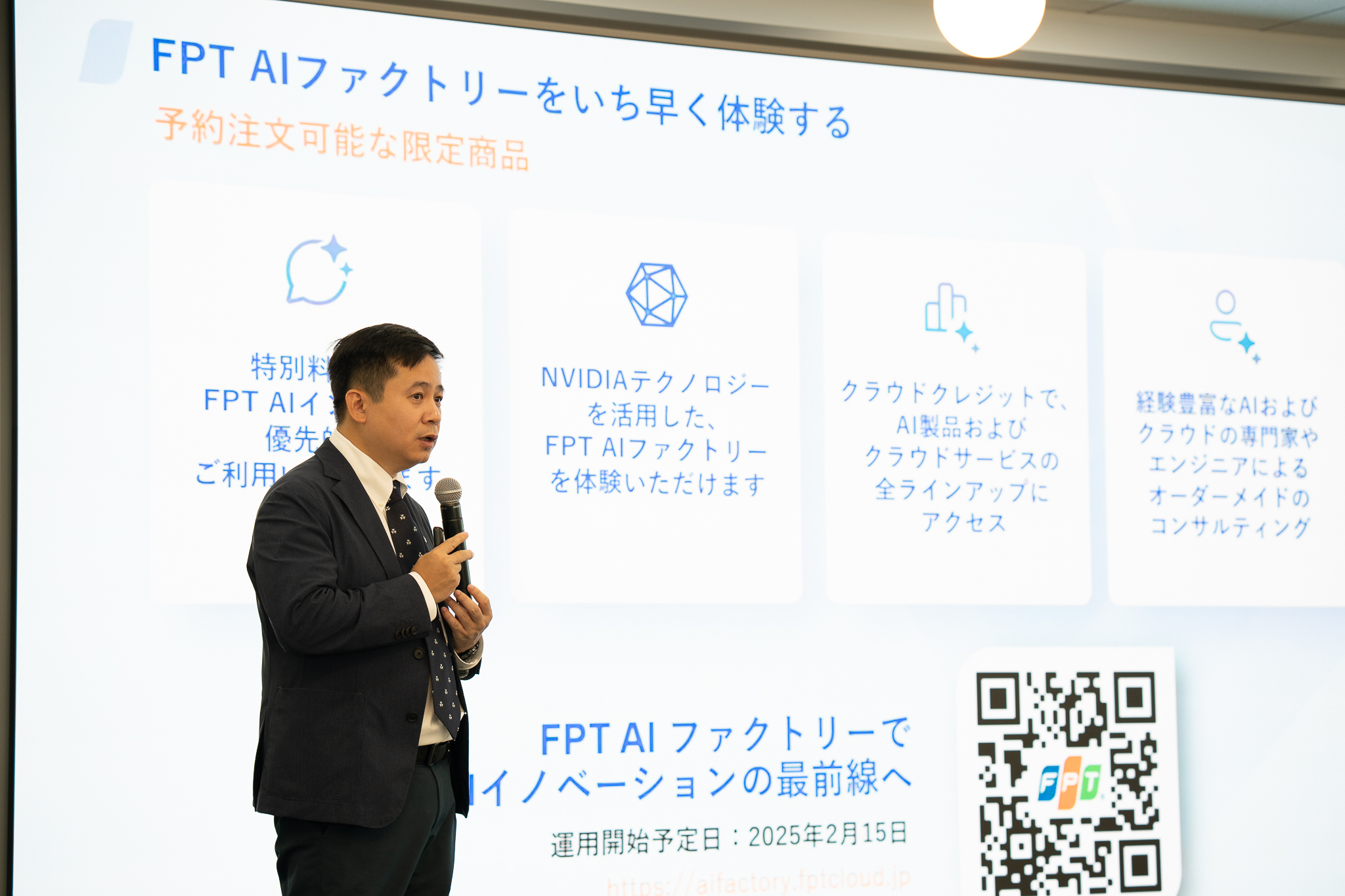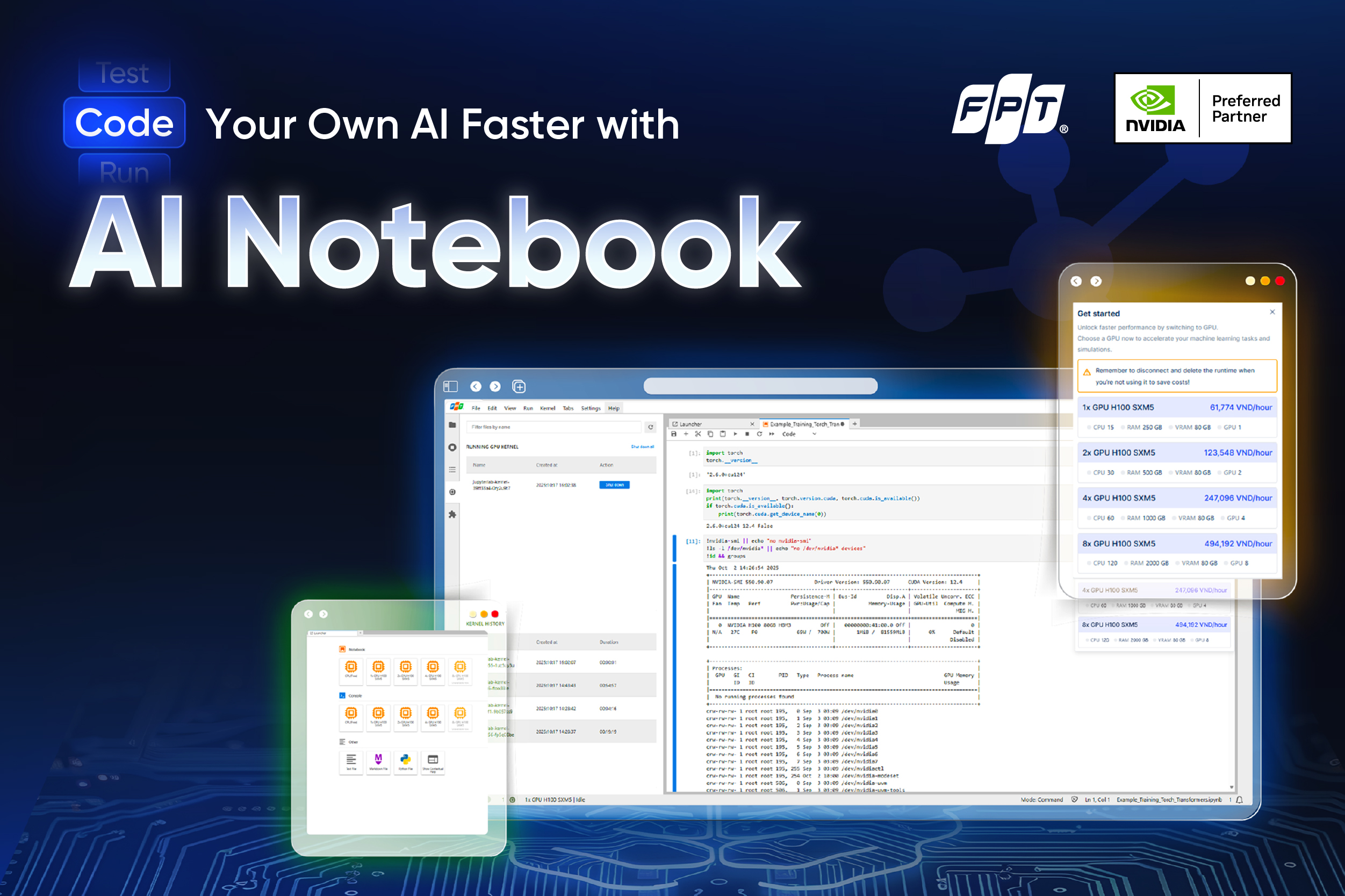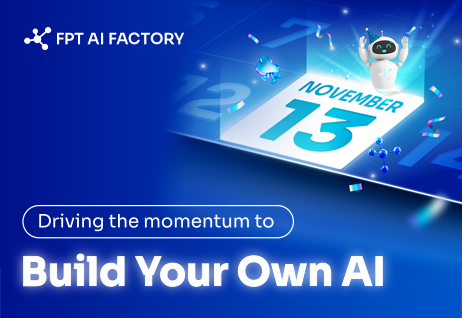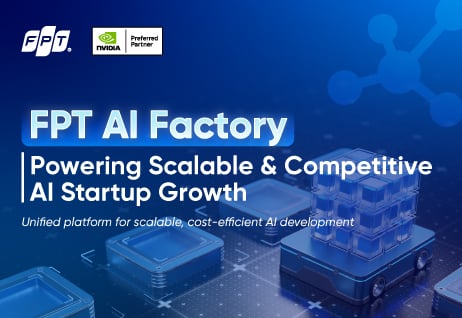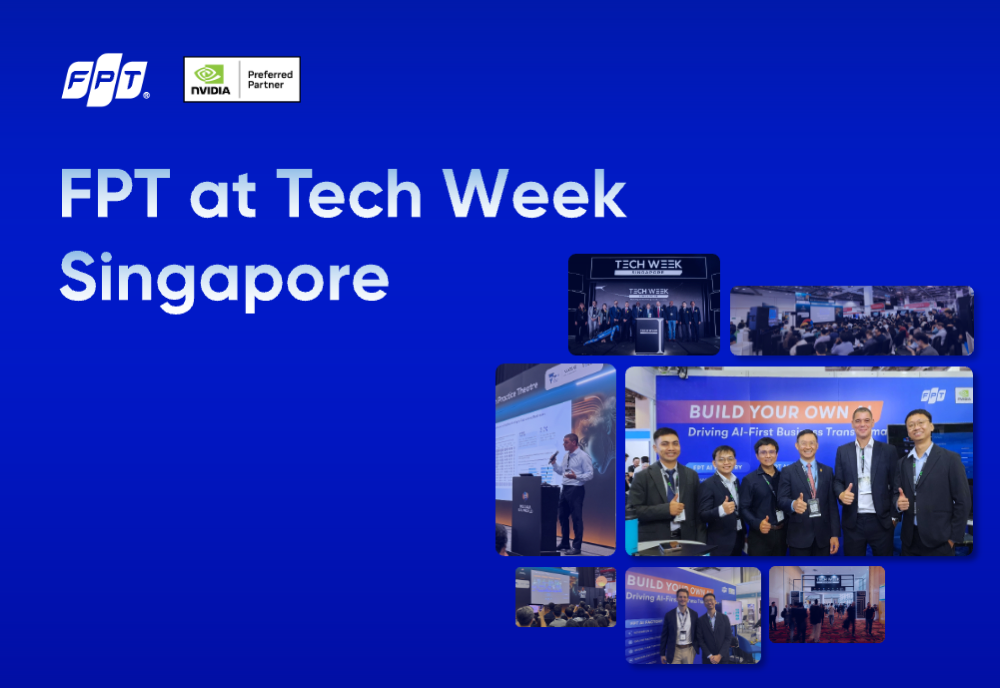Blogs Tech
Categories
Celebrating FPT AI Factory’s 1st Anniversary: Building Up a World-Class AI Ecosystem
09:04 13/11/2025
One year ago, FPT took a bold step toward shaping the future of artificial intelligence, not just for Vietnam, but for the world. That vision became FPT AI Factory, a dynamic hub where innovation, computing power, and creativity converge.
As we celebrate our first anniversary, let’s look back on a journey filled with breakthroughs, partnerships, and progress.
From Vision to Innovation
When FPT AI Factory was founded, the mission was clear: to build a world-class AI ecosystem that empowers organizations and individuals to design, train, and deploy their own AI models with unprecedented speed and flexibility.
In just one year, that vision has transformed into tangible innovation. From advanced AI infrastructure to productized platforms, FPT AI Factory has become a key player in accelerating Vietnam’s AI ambition, while contributing to global progress in AI development.
Built on the Strategic Partnership between FPT and NVIDIA
The foundation of this journey lies in a strategic partnership between FPT and NVIDIA, uniting two forces with a shared purpose: democratizing access to high-performance computing and generative AI.
Through NVIDIA’s cutting-edge technologies and FPT’s AI expertise, the collaboration has enabled the creation of scalable, high-performance AI infrastructure, which is the backbone for thousands of experiments, models, and innovations.
Together, we are making it possible for developers, researchers, and enterprises to bring their ideas to life faster and more efficiently than ever before.
Two AI Factories, One Global Mission
In our first year, FPT AI Factory established two AI factories in Vietnam and Japan, serving as the twin engines of our innovation ecosystem. These AI factories are more than physical data centers. They are collaborative ecosystems designed to empower businesses and communities to co-create AI solutions.
11 New Products, Infinite Possibilities
Innovation never stops at FPT AI Factory. In just one year, our team rolled out 11 new AI products, powering end-to-end AI innovation, fostering the mission to make AI creation accessible, efficient, and scalable, giving every researcher, developer, engineer, and business user the tools to Build Your Own AI.
At the core of this growth are four powerful product lines:
FPT AI Infrastructure: Providing enterprise-grade NVIDIA H100 & H200 GPUs for large-scale AI training and deployment, accelerating everything from foundational models to custom use cases.
FPT AI Studio: Offering an all-in-one platform that enables users to create, fine-tune, and develop their own AI models.
FPT AI Inference: Delivering optimized, cost-efficient inference pipelines to bring AI into real-world applications faster than ever.
FPT AI Agents: Enabling instant AI adoption with an easy-to-use, multi-lingual platform to build and operate AI Agents.
Make-in-Vietnam, for the World
Over the past year, FPT AI Factory has demonstrated that Vietnam’s talent and technological capabilities can have a global impact. Our AI infrastructure and platforms now support initiatives that extend beyond borders, from research collaborations in Asia to AI deployments for global enterprises.
Every milestone achieved at FPT AI Factory is a step toward redefining Vietnam’s role in the global AI landscape, not just as a participant, but as a leader and enabler.
Looking Ahead
As we celebrate one year of progress, we also look forward to new challenges, collaborations, and discoveries. FPT AI Factory will continue to champion open innovation and technological sovereignty, building an ecosystem where the global AI community can learn, experiment, and grow together.
From vision to innovation, we are driving the momentum to Build Your Own AI. Here’s to many more!
Explore FPT AI Factory: https://aifactory.fptcloud.com
FPT Empowers Developers to Fast-Track AI Innovation with AI Notebook Running On NVIDIA Accelerated Computing
00:09 06/11/2025
FPT, a global ICT corporation and an NVIDIA Preferred Partner, introduced AI Notebook - a powerful, managed JupyterLab service that serves as a trusted coding companion for developers and researchers in day-to-day development.
Built upon FPT AI Factory infrastructure, AI Notebook leverages NVIDIA accelerated computing and Jupyter Notebook open-source architecture to provide an elevated cloud-based coding workspace that allows AI engineers, developers, and researchers to prototype, experiment, and refine models — all faster, more securely, and collaboratively, with enterprise-grade reliability.
[caption id="attachment_68075" align="aligncenter" width="1024"] A cloud-based platform for developers to accelerate AI research and development[/caption]
As organizations accelerate their adoption of AI, the demand for faster experimentation and more efficient model development continues to rise. Designed with developers in mind, AI Notebook eliminates Jupyter Notebook deployment hurdles to create a ready-to-use development environment and minimizes infrastructure overhead with optimal high-performance GPU options. This enables AI developers, data scientists, and students to shorten research and experimentation cycles, ultimately delivering results faster.
Key benefits for the AI Notebook include:
Accelerated experimentation and productivity: Provides a unified, pre-configured environment that gives developers a fast, intuitive experience to write and test code, explore data, build, and iterate on AI models interactively. That streamlines the workflow from early research to model training and fine-tuning, accelerating the journey from ideas to working models.
Performance at scale, payment on demand: Offers access to a range of NVIDIA H100 and NVIDIA H200 Tensor Core GPU configurations to match different stages of model development, delivering the performance needed to scale workloads seamlessly. A free starter setup is also available with no upfront cost, giving them sufficient capacity for basic experiments and evaluation before scaling to GPU acceleration. Flexible and transparent pay-as-you-go pricing with no hidden fees or data transfer charges ensures cost efficiency and the freedom to innovate.
Enhanced collaboration and project management: Creates a collaborative space with advanced features that allow for running multiple projects in parallel, each workspace serving as a dedicated lab. Experiments and progress are centralized in one place, making it easy to compare results, reuse prior work, and move smoothly from research to production.
Secure innovation: Built on NVIDIA AI infrastructure with enterprise-grade reliability, it ensures safe, compliant, and efficient AI development. Developers can innovate with confidence, knowing data and workloads are fully protected.
Mr. Le Hong Viet, CEO of FPT Smart Cloud, FPT Corporation, emphasized, “Our vision is to empower every organization to build their own AI, tailored to their unique data, knowledge, and culture. With NVIDIA-accelerated FPT AI Factory and its next-generation GPUs, our platforms provide AI researchers, engineers, and developers with the tools to create, train, and scale models with enterprise-grade performance. By removing infrastructure barriers and optimizing costs, we make AI development more efficient, scalable, and practical — enabling organizations to innovate faster, smarter, and with greater independence.”
Availability
Developers can sign up to explore AI Notebook while exploring other NVIDIA-accelerated services on FPT AI Factory. Visit https://ai.fptcloud.com/ to learn more and get started.
Dive into Claude Haiku 4.5: Faster, Smarter, and More Affordable
16:58 05/11/2025
After the release of Claude Sonnet 4.5, considered a world-class model for programming and agentic use, Anthropic has introduced its newest small model: Claude Haiku 4.5. According to Anthropic, this model delivers better performance than Sonnet 4, while costing one-third as much and running at more than double the speed.
Claude Haiku 4.5 is engineered for high-volume, low-latency, cost-sensitive deployments. If your workload involves long-running sequences, many calls to LLMs, or you need to spin up multiple agents in parallel, this is a major shift.
Key technical highlights
Claude Haiku 4.5 is described as a “small, fast model” in Anthropic’s classification. It sits below the “frontier” models but delivers near-frontier coding and reasoning performance at a much lower cost.
On SWE-bench Verified (a real-world software engineering test using GitHub issues), Claude Haiku 4.5 scored ~73.3%. By comparison, Claude Sonnet 4.5 scored ~77.2%.
Claude Haiku 4.5 supports both text and image inputs and is capable of extended reasoning, computer-use, and tool-assisted workflows.
The model is available via Claude’s API at USD $1 per 1 million input tokens and $5 per 1 million output tokens. This is significantly lower than higher-tier models.
In terms of safety and alignment, Anthropic assigns Haiku 4.5 under its AI Safety Level 2 (ASL-2) standard, which is a less restrictive classification than the ASL-3 assigned to the bigger models, and reports improved behaviour in alignment benchmarks.
What this means for applications & users
For developers, product teams, and businesses, Claude Haiku 4.5 opens up new possibilities:
Cost-sensitive workflows: When you are running thousands or tens of thousands of model calls (e.g., customer service assistants, chatbots, embedded agents), the lower cost per token matters.
Speed/latency-critical use cases: Claude Haiku 4.5 is faster, so it is well-suited for real-time interaction, multi-agent orchestration, or workflows where response speed is key.
Scaling agents: If you architect a system with a top-tier model as the “brain” and multiple sub-agents handling sub-tasks, Claude Haiku 4.5 offers a faster, cheaper sub-agent tier without sacrificing too much in capability.
Maintain high capability: Claude Haiku 4.5 offers near what was considered cutting-edge only months ago, along with more affordable pricing for many real-world coding, tool-use, and reasoning tasks.
Flexibility in deployment: Claude Haiku 4.5 is available on Claude Code and Anthropic’s apps. Developers can access the model via API and on major cloud platforms (e.g., Amazon Bedrock, Google Cloud’s Vertex AI), making model adoption smoother.
Conclusions
The era when only the most expensive models could deliver top performance is changing. With Claude Haiku 4.5, Anthropic offers a compelling value proposition: remarkable performance, fast speed, and significantly lower cost. For organizations looking to embed AI agents, deploy at scale, or experiment with generative AI workflows, this model opens doors that were previously constrained by budget or latency.
If you are working on AI-powered systems (chatbots, cloud agents, generative workflows), Claude Haiku 4.5 may well allow you to iterate faster, deploy more broadly, and keep your TCO (total cost of ownership) in check.
Source: https://www.anthropic.com/news/claude-haiku-4-5
The Role of Artificial Intelligence in Shaping the Future of the Automotive Industry
13:13 28/10/2025
Artificial Intelligence (AI) has emerged as a strategic tool as the automotive industry pursues ambitious goals, such as improving operational efficiency, enhancing customer experiences, and prioritizing environmental sustainability.
1. The Significance of AI in the Automotive Industry
With a suite of breakthrough features, AI is enhancing operational performance and optimizing production processes within the automotive sector. According to NVIDIA, European manufacturers, including BMW Group, Maserati, Mercedes-Benz and Schaeffler, are integrating AI into smart production lines, enabling real-time data monitoring and analysis to improve product quality, minimize errors, and increase precision at every stage.
Additionally, AI technologies also support long-term customer relationships by delivering personalized services such as virtual assistants, autonomous driving systems, and after-sales services.
2. Applications of AI in the Automotive Industry
Manufacturing and Supply Chain Management
Artificial Intelligence serves as a critical enabler in automotive production and supply chain management. Companies like BYD have implemented AI on production lines, leveraging intelligent robots and predictive systems to optimize workflows, minimize errors, and increase productivity. These robots are capable of learning and self-adjusting while improving accuracy in tasks such as welding, assembly, and quality inspection.
In supply chain management, AI helps forecast market demand, optimize warehouse operations, and manage logistics efficiently. A notable example is Ford, which uses AI to analyze production and supply chain data, enhancing tracking capabilities, precise component transportation, and on-time delivery.
Furthermore, this technology also contributes to reducing carbon emissions and optimizing operational costs. These benefits are driving the automotive industry closer to a fully smart manufacturing model.
AI in Vehicle Features to Assist Drivers
To ensure safety and elevate the customer experience, leading automakers are deeply integrating AI into modern vehicles. One of the most common applications is Advanced Driver Assistance Systems (ADAS), which include automatic braking, lane departure warnings, adaptive cruise control, and driver drowsiness detection. These systems use artificial intelligence to analyze sensor and camera data, identifying risks and assisting drivers promptly, thereby reducing the likelihood of accidents.
Additionally, in modern vehicles, the Surround View Monitoring (SVM) systems harness artificial intelligence to provide a full 360-degree view of the surroundings. Combining information from cameras and sensors, these systems guide drivers through narrow spaces, facilitate accurate parking, and reduce the risk of collisions. By enhancing situational awareness, SVM contributes to both safety and comfort, providing drivers with a more intuitive and enjoyable experience behind the wheel.
After-Sales Services
Automakers are increasingly integrating artificial intelligence into after-sales services to enhance customer satisfaction and streamline maintenance processes. Intelligent systems can analyze large volumes of vehicle usage data to predict maintenance needs, schedule timely repairs, and suggest parts replacements before issues arise.
In Vietnam, VinFast has implemented AI-driven diagnostics and predictive maintenance tools to provide proactive support to its customers. Globally, Toyota leverages AI to optimize service scheduling, monitor vehicle health, and offer personalized recommendations, improving the overall ownership experience.
3. AI Factory: Providing Next-Gen AI Infrastructure for the Automotive Industry
Robust AI infrastructure serves as a foundational platform, enabling companies to fully leverage the potential of artificial intelligence. With capabilities to process and analyze massive datasets, a strong infrastructure not only optimizes operational performance but also unlocks opportunities for groundbreaking AI innovations. This is particularly crucial in the automotive sector, where technological advancements and data-driven insights can drive significant progress in developing advanced solutions—from autonomous driving to optimized production and supply chain management. Therefore, AI Factory has become an indispensable pillar for the manufacturing industry.
In Europe, NVIDIA is building the world’s first AI factory that will support industrial AI workloads for European manufacturers. This Germany-based AI factory will feature 10,000 GPUs, including through NVIDIA DGX™ B200 systems and NVIDIA RTX PRO™ Servers, and enable Europe’s industrial leaders to accelerate every manufacturing application.
Furthermore, cloud providers in Japan, such as GMO Internet, Highreso, KDDI, Rutilea, SAKURA Internet, and FPT are leveraging NVIDIA-powered AI infrastructure to revolutionize industries including robotics, automotive, healthcare, and telecommunications.
In Asia, FPT launched FPT AI Factory in Japan and Vietnam, equipped with thousands of cutting-edge NVIDIA H100/H200 GPUs, delivering exceptional computing power. With this computational strength, businesses are allowed to drastically reduce research time while accelerating AI solution development and deployment by more than 1,000 times compared to traditional methods. This creates vast opportunities for turning ideas into reality and applying AI to enhance efficiency and innovation across all areas.
FPT AI Factory – The Launchpad for Next-Gen AI Startups
11:24 22/10/2025
In today’s fast-evolving AI landscape, startups and ventures face a common challenge: how to transform bold AI ideas into real-world solutions fast, efficiently, and securely.
At IGNITE 2025, Mr. Pham Vu Hung, Solutions Architect of FPT Smart Cloud, FPT Corporation, shared how FPT AI Factory serves as a launchpad for the region’s AI ecosystem by providing startups with the infrastructure, technical expertise, and collaborative network they need to scale their innovations from concept to market.
Image. Mr. Pham Vu Hung at IGNITE 2025
Empowering Startups to Build, Scale, and Thrive
FPT AI Factory combines the best of global technology and local proximity, offering a powerful platform for startups to build and scale AI solutions closer to their markets.
With the AI infrastructure powered by NVIDIA H100/H200 GPUs (ranked 36th and 38th in the TOP500 list, June 2025), FPT AI Factory delivers world-class performance while ensuring data sovereignty, security, and low latency for customers. More than that, FPT AI Factory offers a complete ecosystem designed to help startups and innovators accelerate AI development, deployment, and growth.
1. Flexible yet powerful AI infrastructure
Startups can easily access GPU-powered environments tailored to their needs, from GPU Container for experimentation to Virtual Machine and FPT AI Studio for production workloads. This flexibility allows early-stage organizations to build, test, and deploy AI models quickly while keeping operational costs under control.
2. No-code/low-code platforms to build AI
With FPT AI Studio, startups can develop and fine-tune AI models using a visual drag-and-drop interface, with no deep coding required. Once trained, these models can be deployed instantly via FPT AI Inference, enabling rapid market validation and iteration.
3. Expert guidance and technical support
FPT AI Factory provides not only computing resources but also hands-on technical consultation, helping teams choose optimal architectures, fine-tune models, and design efficient AI workflows. For startups without large in-house AI teams, this means faster development with lower risk.
4. Scalable growth within a secure, regional ecosystem
As startups scale, FPT AI Factory provides the solid foundation they need, from GPU Clusters and Kubernetes orchestration to secure storage and MLOps tools, all hosted in state-of-the-art data centers. With this setup, startups can build and deploy AI solutions with low latency and strong data protection.
From Concept to Market: Real Impact Across the Region
Mr. Hung showcased how FPT AI Factory has supported startups and enterprises in the region to achieve faster time-to-market.
One standout case involves a Japanese IT company that fine-tuned a 300GB document understanding model using GPU Container and Object Storage on FPT AI Factory. The company is then able to achieve faster iteration cycles, optimized costs, and a more efficient path from prototype to production.
Another highlight was a live demo of an AI Camera Agent capable of video search and summarization that is built in just one day using NVIDIA Blueprints and deployed on FPT AI Factory. This case demonstrates how startups can move from idea to working prototype with remarkable speed.
Image. AI Camera Agent built on FPT AI Factory
Why AI Startups Choose FPT AI Factory
By offering the right foundation of infrastructure, expertise, and ecosystem connections, FPT is empowering a new generation of AI startups to grow beyond borders and lead the region’s digital transformation.
Get started fast: Access GPU-powered AI environments within minutes.
Scale flexibly: Choose the right compute option for each stage of growth.
Reduce time-to-market: Build and deploy AI models rapidly with ready-to-use tools.
Stay secure and compliant: Operate in top-tier, regionally hosted data centers.
Collaborate across borders: Connect with FPT’s AI experts, partners, and investor network.
Connect with our experts and explore FPT AI Factory now: https://aifactory.fptcloud.com
FPT AI Factory: Powering Scalable and Competitive AI Startup Growth
16:20 21/10/2025
Artificial intelligence (AI) is emerging as a powerful driver of transformation, reshaping economies and societies across the globe. Day by day, AI is accelerating innovation, enhancing productivity, and delivering solutions to complex challenges across diverse industries. For developing countries, AI represents a strategic opportunity to drive growth, strengthen competitiveness, and build a resilient, future-ready economy.
Yet, while AI offers immense opportunities, startups often encounter a critical bottleneck when it comes to accessing the high-performance computing infrastructure needed to turn ambitious ideas into impactful solutions. The rapid growth of AI has created an unprecedented demand for GPUs and other computational resources. Startups seeking to develop cutting-edge AI solutions, from generative models to advanced analytics, must harness powerful infrastructure to train models efficiently, handle massive datasets, and iterate quickly.
In this fiercely competitive landscape, success is determined not only by creativity, but also by speed, scalability, and the ability to deploy solutions reliably. Startups that can leverage the right resources gain a decisive edge, while those constrained by limited computing power risk falling behind.
The Infrastructure Gap Hindering AI Startup Scalability
Amid this rapid AI evolution, startups face intense competition where speed, efficiency, and differentiation often determine survival. Turning innovative ideas into impactful AI solutions requires more creativity and ambition; it demands access to high-performance computing infrastructure capable of handling complex workloads. Training and fine-tuning large-scale AI models, particularly in domains like generative AI, relies on powerful GPUs, scalable storage, and flexible systems that can swiftly adapt to rapidly changing demands.
Yet, building such infrastructure independently is often out of reach for most startups. High upfront expenses, ongoing maintenance, and specialized expertise strain limited budgets, making it difficult to experiment at scale. Limited computing power can slow model training, restrict data processing, and prevent rapid iteration to meet customer or investor expectations. At a practical startup level, accessing sufficient compute represents a significant investment, reflecting the projected growth of the global high-performance computing market from 55.2 billion USD in 2024 to 101.48 billion USD by 2033. For example, a startup training a mid-size generative AI model may require a cluster of 8 - 16 high-end GPUs, which can cost tens of thousands of USD per month in cloud compute alone. These expenses often force startups to scale down experiments or prolong model development, creating a tangible infrastructure gap compared to better-funded competitors.
Additionally, beyond hardware, startups also face human capital challenges. Recruiting and retaining AI engineers, data scientists, and ML operations specialists is highly competitive and costly. Even with talent in place, coordinating teams to handle complex AI pipelines efficiently demands robust operational processes, something many young companies have yet to fully establish.
Emerging AI companies face many challenges, including high infrastructure costs, limited talent, and constant pressure to deliver fast results. These factors pose a significant barrier to entry and make it difficult for startups to compete effectively on a global scale. Balancing computational strength, cost efficiency, and human resources has therefore become one of the most pressing hurdles for startups striving to compete on a global stage. Without solutions to these constraints, even the most innovative ideas risk never reaching their full potential.
Introducing FPT AI Factory: A Comprehensive Suite for End-to-End AI Product Lifecycle
Recognizing the growing demands of AI development, FPT has partnered with NVIDIA to launch FPT AI Factory – a comprehensive platform designed to help organizations accelerate their AI journey with confidence.
More than a toolset, FPT AI Factory is a robust ecosystem combining cutting-edge GPU infrastructure, pre-built AI applications, and a unified environment for model training, fine-tuning, and deployment. It provides businesses with speed, scalability, and flexibility to build, optimize, and operationalize AI solutions efficiently.
Whether developing custom generative AI models, refining architectures, or deploying AI-driven services, FPT AI Factory delivers computational power and streamlined workflows to turn ideas into impactful innovations.
The “Build Your Own AI” Philosophy
A core philosophy of FPT AI Factory is “Build your own AI.” This enables startups and enterprises to create custom models tailored to their business needs. Success requires the right combination of infrastructure, tools, and applications, allowing companies to experiment freely, iterate quickly, and deploy with confidence.
At its core, the platform leverages NVIDIA H100 and H200 GPUs, high-performance storage, and GPU containers. Complementing this, FPT provides AI Studio for model testing, fine-tuning, and data management, and AI Inference for flexible deployment. Live models can interact with users through AI agents and applications, generating tangible business value.
Use Cases Across Industries
Beyond philosophy, the true impact of FPT AI Factory is best seen through practical applications across different sectors:
Banking & Finance
Develop and deploy LLM-powered voicebots for customer service.
Host image processing models for eKYC: ID verification, facial recognition, and deepfake detection.
Build personal financial assistants capable of analyzing reports and synthesizing financial news.
Healthcare
Deploy AI models for early diagnosis of breast cancer and cytology analysis.
Run image analysis workloads on GPU containers to interpret ultrasound scans more efficiently.
Biotech
Apply genetic code analysis solutions to accelerate biological research and drug discovery.
Technology
Develop chatbots for customer service and internal support.
Train and fine-tune custom AI models based on business-specific data.
Build large-scale visual AI models for multi-task processing, ensuring reliable system operations.
Operate AI agents using models like DeepSeek to enhance sales processes and customer engagement.
These examples illustrate how AI capabilities can be transformed into real-world solutions when supported by the right infrastructure and platforms.
Empowering the Next Wave of AI Startups
In today’s highly competitive AI ecosystem, the ability to develop, train, and deploy models efficiently can determine a startup’s success. FPT AI Factory provides not only the technological foundation but also practical pathways for innovation.
By embracing the “Build Your Own AI” approach and leveraging real-world use cases across industries, startups and enterprises can accelerate their AI journey, moving from ideas to impactful applications faster, smarter, and more cost-effectively.
FPT at Tech Week Singapore 2025: Pioneering the Future of AI-Powered Business Transformation
10:41 14/10/2025
At Tech Week Singapore 2025 – one of the largest tech events in the APAC, FPT showcased its latest innovations in Artificial Intelligence, reinforcing its position as a leading technology partner for enterprises looking to drive intelligent transformation. With a strong focus on robust infrastructure, enterprise-ready AI platforms, and agentic AI capabilities, FPT attracted the attention of business leaders, technology professionals, and innovators from across the region.
Spotlight on AI Innovation at the FPT Booth
The FPT booth served as a gateway into the future of AI-powered enterprises, introducing a suite of advanced solutions designed to help businesses harness AI at scale and speed.
Image. The Vietnamese Ambassador in Singapore visited FPT’s booth
FPT AI Factory: End-to-End AI Development at Scale
For developers, researchers, and AI engineers, FPT introduced the FPT AI Factory – a comprehensive solution that accelerates the full AI development lifecycle. Leveraging the latest NVIDIA H100/H200 GPUs, FPT AI Factory empowers organizations to train, fine-tune, and customize AI models using proprietary data, unlocking new levels of productivity and innovation.
FPT AI Agents: Multilingual, Multi-Channel, Ready to Deploy
Visitors experienced firsthand the FPT AI Agents platform, enabling organizations to create and operate multilingual AI Agents across multiple channels. With over 20 ready-to-use AI applications including Telesales Agents, Omni-channel AI Agents, Quality Control Agents, and Admin Agents, the platform offers immediate value by automating customer interactions, enhancing service delivery, and improving operational efficiency at a fraction of costs.
Accelerating Solutions with NVIDIA-Powered Technologies
FPT also highlighted how its AI solutions are built to take full advantage of cutting-edge NVIDIA technologies such as NVIDIA Blueprint and NVIDIA AI Enterprise. These tools allow FPT to optimize AI infrastructure and rapidly design scalable solutions across a variety of industries. From high-performance compute environments to integrative products and services, FPT is enabling businesses to go from concept to deployment faster than ever.
Keynote Highlight: Unlocking the Future with AI Factory and Agentic AI
A major highlight of FPT’s participation was the keynote by Mr. Mark Hall Andrew, Chief Revenue Officer of FPT Smart Cloud, FPT Corporation titled: "From AI Factory to Agentic AI: Building the Future of Intelligent Enterprises."
In his presentation, Mr. Mark Hall painted a compelling picture of how AI is rapidly transforming the global and, specifically, Asia/Pacific economy, reshaping GDP growth, redefining workforce structures, and creating new competitive advantages. At the core of this transformation is the emergence of AI Agents, offering businesses a revolutionary new way to collaborate with intelligent systems.
Image. FPT’s keynote presented by Mr. Mark Hall Andrew at the AI & Data in Practice Theatre
He introduced FPT’s “Build Your Own AI” strategy, aiming to help organizations become AI-native enterprises by embedding intelligence into every layer of operations. According to Mr. Hall Andrew, FPT’s approach is structured around three foundational pillars:
1. Enterprise AI: Driving End-to-End Transformation
With the Rapid AI Deployment Factory and AI Architecture Design, FPT empowers enterprises to integrate AI into customer engagement, product development, and internal processes. These offerings are designed for scalability, security, and quick time-to-value, aligning with business transformation goals.
2. Industrial AI: Enabling Smart Manufacturing
In manufacturing, FPT leverages Agentic AI and NVIDIA technologies such as Omniverse, IsaacSim, and Gr00t to optimize processes, automate robotics, and simulate operations using digital twins. These solutions are not just theoretical; they are already helping manufacturers streamline operations and boost productivity.
3. AI Infrastructure: Building the Foundation for Scalable Intelligence
Finally, FPT helps organizations modernize their data and AI infrastructure with enterprise-grade architecture. This includes maximizing hardware efficiency while ensuring robust security and scalability, which are critical requirements for sustained AI adoption.
The backbone of these pillars is FPT AI Factory - a unified, end-to-end stack that brings together data, infrastructure, and AI models to accelerate innovation. FPT AI Factory serves as the foundation for developing and deploying AI Agents at scale, enabling enterprises to seamlessly move from experimentation to real-world adoption. By combining advanced computing power, domain-specific expertise, and an open, collaborative ecosystem, FPT is helping organizations across the APAC and beyond build the future of intelligent, AI-native enterprises.
Charting the Future of AI Together
Tech Week Singapore 2025 marked not just another milestone for FPT, but a clear statement of intent. AI is no longer a future aspiration. It is a present-day imperative. FPT stands ready to help businesses navigate this new era, offering scalable, secure, and intelligent AI solutions tailored to real-world needs.
As AI continues to reshape industries, FPT is committed to being a trusted partner in helping organizations unlock their full potential with future-ready technologies.
------
Ready to accelerate your AI journey? Explore our AI solutions or get in touch to discover how FPT can support your transformation into an AI-native enterprise.
Connect now: https://fptsmartcloud.vn/8USYu
What’s New on FPT AI Factory
16:39 30/09/2025
Welcome to FPT AI Factory Release Notes! Here we’ll provide regular updates on what’s happening across the FPT AI Factory ecosystem from new product features to infrastructure upgrades, billing improvements, and more.
September, 2025
August, 2025









